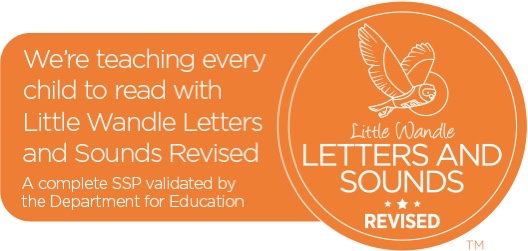
Phonics and Early Reading

What is phonics?
Phonics is a way of teaching children how to read and write, helping children to hear, identify and use different sounds to read and write. The English language has: 26 letters, 44 sounds and over 100 different ways to spell these sounds. Phonics sessions teach the children all of these.
How do we teach phonics and reading at Kender?
Phonics
At Kender we use ‘Little Wandle: Letters and Sounds’ to teach the children. This programme is validated by the Department for Education.
In the nursery, children begin to develop the skills necessary for reading and writing. These skills are taught through games, songs, music and stories.
There are 7 aspects covered:
- General sound discrimination: Environmental sounds
- General sound discrimination: Instrumental sounds
- General sound discrimination: Body percussion
- Rhythm and rhyme
- Alliteration
- Voice Sounds
- Oral blending and segmenting.
Children then begin to explore initial sounds in the environment with a focus on one sound a week.
In Reception to Year 2, Phonics is taught through daily carpet sessions. The sessions follow a consistent pattern of:
- Revisit and Review
- Teach and Practice
- Practice and Apply
Children are then assessed each half-term to monitor their progress, ensuring that by the end of Year 2, children are confident in all 44 sounds and how they are used.
Children who are finding phonics challenging are supported through daily 'Keep-Up' sessions.
Year One Phonics Screening
At the end of Year One, children are expected to take the 'Year One Phonics Screening'. This is a statutory government assessment to ensure that children are getting the required phonics knowledge to support their learning.
The assessment asks the children to segment and blend 40 words, real words and alien (pretend words). This process reflects much of the practice we do daily in the classroom and so is familiar to the children.
Reading
At the start of Reception, children will be given wordless books whilst they learn sound-letter correspondence. Once they have learnt a sufficient number of sound-letter correspondences, the children move on to books using those initial sounds.
Children are then read with in a small group twice a week and 1:1 with an adult once a week. These phonics books are then taken home, along with a sharing book of their choice.
In Year 1 and Year 2, children read phonics related books in small groups twice a week and 1:1 with an adult once a week. These phonics books are then taken home, along with a sharing book of their choice.
Children are assessed each half-term and their books are levelled to ensure they are reading at the appropriate level.
Families are expected to read with their child daily for a short period of time. The child should read their phonics book to the adult for 5-10 minutes, depending on their ability, and the adult should read a sharing story book with them to develop their ability to discuss books and build a love of reading. Children will be given a reading record which a family member should write in once per week to give the school feedback.
Please find below additional resources to support your child with reading and phonics...
